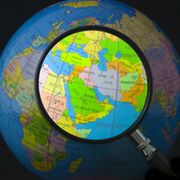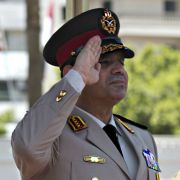Economics and the Gaza War
 The Gaza Strip has an area of 360 square kilometers (139 square miles) and a population of some 1.8 million. In 2013, GDP was $2.9 billion and GDP per capita was just over $1,600 – or under $5 a day. The poverty rate was 39 percent and the extreme poverty rate was 21 percent while unemployment was 41 percent. Unemployment among those aged 15 to 24 years was 57 percent. As a result of the recent fighting, all these figure have sharply worsened.
The Gaza Strip has an area of 360 square kilometers (139 square miles) and a population of some 1.8 million. In 2013, GDP was $2.9 billion and GDP per capita was just over $1,600 – or under $5 a day. The poverty rate was 39 percent and the extreme poverty rate was 21 percent while unemployment was 41 percent. Unemployment among those aged 15 to 24 years was 57 percent. As a result of the recent fighting, all these figure have sharply worsened.
Another factor that has contributed to tensions in Gaza, as elsewhere in the Middle East, is the rapid growth of the population and its age structure. Population growth has been estimated at three percent a year or more, adding at least 50,000 people annually. In the last decade the population has increased by 43 percent and according to the United Nations, by the year 2020 it will reach 2.1 million. The population is also very young: 50 percent of the population is under the age of 14, and the median age is seventeen. Population control policies are, however, unthinkable under the Islamic government that has ruled for the last seven years.
Much has been written about the link between economic misery and political extremism. Indeed one of the main explanations for the “Arab Spring” uprisings has been the weak performance of economies in the region (see: “The Politics and Economics of the Arab Spring”). This suggests that improving economic conditions would lead to greater political stability and nowhere is this needed more than in Gaza, which has been subject to so much conflict. Rebuilding Gaza's economy will reduce suffering, frustration and thus discourage political extremism, the ultimate manifestation of which has been terrorist attacks against Israel.
In 2005 Israel withdrew from Gaza, removing thousands of settlers and transferring some economic assets to the Palestinians all of which were destroyed. Following Hamas’s victory in the 2006 Palestinian legislative elections, Hamas and Fatah formed a Palestinian Authority national unity government but conflict between them increased.
In January 2006 the Quartet (United States, Russia, United Nations, and European Union) made foreign assistance to the Palestinian Authority (PA) conditional on the future government's commitment to non-violence, recognition of the State of Israel, and acceptance of previous agreements. Hamas rejected these demands and in March 2006 established a Hamas dominated government, which resulted in the Quartet suspending its assistance.
By 2007, Hamas was unable to manage the government and pay salaries and failed to achieve recognition from European donor countries and international organizations. With Hamas in control of the Gaza Strip and Fatah in control of the West Bank, there were de facto two Palestinian governments, both considering themselves to be legitimate. With the dismissal of the Hamas cabinet members by Palestinian President Mahmud Abbas, Hamas Prime Minister Ismaʿil Haniyeh refused to acknowledge the dismissal of his government, but had to establish a new Gaza-based Hamas government in June 2007, as its West Bank resident ministers in the Palestinian government were deposed by Fatah. On taking power, Hamas announced that it would refuse to honor past international agreements between the Palestinians and Israel. As a result, the United States and the EU cut off aid to the Gaza Strip, and Israel and the Middle East Quartet implemented punitive economic measures against Hamas in Gaza. Prior to disengagement, up to 120,000 Palestinians from Gaza had been employed in Israel or in joint projects. After the Israeli withdrawal, the gross domestic product of the Gaza Strip declined, Israeli enterprises shut down, work relationships were severed, and job opportunities in Israel for Gaza residents dried-up.
Following the Hamas takeover of Gaza in 2007, the EU, US, and Israel showed public support for the new Fatah administration based in Ramallah without Hamas. The EU and US normalized ties with the Palestinian National Authority and resumed direct aid. Israel announced that it would return frozen tax revenue of approximately $800 million to the new Fatah administration. The UN stated that aid to the Palestinian Authority would hinge on the government's commitment to peace and recognizing Israel. Hamas has rejected this and has therefore not been eligible for international assistance, although it did receive some assistance from Qatar and others. In late June 2008, Egypt, Jordan, and Saudi Arabia said that the West Bank-based cabinet formed by Abbas was the sole legitimate Palestinian government and Egypt moved its embassy from Gaza to the West Bank.
In September 2007 the Israeli government declared the Gaza Strip a “hostile territory” and ordered the Israeli Defense Forces (IDF) to impose restrictions on the movement of goods and people in and out of the Gaza Strip, with humanitarian exceptions. From 2007 until 2014, Gaza remained under tight Israeli economic restrictions and varying levels of Egyptian pressure. The latter increased massively in July 2013 when President Muhamed Morsi was removed from office. In response to missile attacks, Israel has launched three major military operations against Hamas in Gaza: Cast Lead in 2008-2009, Pillar of Defense in 2012, and Protective Edge in 2014. The 2014 operation involved a sustained ground operation and was thus more destructive than those in 2009 and 2012.
The Gaza economy has therefore been under blockade since 2007. In a draft paper entitled When Trade Stops: Lessons from the Gaza Blockade 2007-2010, Haggay Etkes and Assaf Zimring compared the development of Gaza's economy with that of the West Bank, which was not blockaded. They found that welfare (measured by output) in Gaza was between 14 percent and 27 percent lower than in the West Bank because of the blockade. One of the implications of their work is that an end to the blockade – of exports as well as imports – would have significant beneficial effects on Gaza's economy.
In the summer of 2013 Hamas began struggling to meet its payroll. Income from taxes had been badly hit after Egypt started destroying a network of tunnels used to smuggle food, fuel, and weapons into Gaza. This meant that thousands of civil servants did not receive their full salaries. Egypt, which accused Hamas of aiding Muslim militants in the Sinai, had been waging a campaign to destroy the tunnels that were used to smuggle weapons and other goods into Gaza. Hamas taxed the traffic through the tunnels and that source of revenue ended when the tunnels were destroyed. In the early years of the blockade, the Hamas-led government in Gaza survived economically by taxing the tunnel trade and this enabled it to devote large resources to its military struggle with Israel. By 2013, however, Hamas, whose budget had been heavily dependent on Iranian and Qatari support and also that from the Muslim Brotherhood in Egypt, lost most of its external support. At the same time, the Hamas government lost its revenues from the tunnels, or approximately $500 million a year out of an annual budget of just under $900 million.
By 2014 Gaza’s economy was in a deep crisis, with 70 percent of residents dependent on humanitarian aid before the recent war. Employees of the former Hamas government stopped receiving salaries after a new technocratic national unity cabinet with Fatah was formed in April 2014. Under pressure from the U.S., funds from Qatar to the 44,000 Hamas personnel did not reach Gaza. Prior to the recent war, the limits on fuel supplies allowed into Gaza meant that Gaza residents suffered power cuts of up to eight hours a day. Unemployment stood at more than 40 percent before the current round of fighting, and construction — one of Gaza’s biggest sectors — shed 17,000 jobs over the last year, after the import of cement was halted.
$5-6 billion is needed for reconstructing the infrastructure and housing in Gaza. This sum is not large by international standards, but, as usual, political factors stand in the way. Private capital is even more sensitive to the political environment and will take longer to encourage.
Gaza has economic potential, including development of tourism along the coast, services, and even high tech. The production of natural gas, which was discovered off-shore, near Gaza, has great potential. The field is estimated to contain one trillion cubic feet of gas and to have a production life of 15 years. The project could deliver major economic, environmental, and financial benefits to the Palestinians, generating estimated revenues of approximately $2.4 billion in royalties and taxes over its life. It will also save $550 million annually by eliminating the need to import electricity from Israel. The Palestinians will also be able to replace the diesel currently being used by the Gaza power station with gas. This will significantly reduce the cost of generating electricity for Gaza.

Pictured: Gaza City. Photo by Wikimedia Commons
The access to substantial gas reserves will allow the Palestinians to invest in the development of natural gas fired power plants. Traditional agricultural crops, many of which were originally developed with Israeli aid, also have export potential that would be restored by an agreement. There is also human capital with economic potential: there is almost no illiteracy in Gaza and there are five universities.
The problem is how to reconstruct Gaza without enabling Hamas to rearm. An attempt is being made to reintroduce Palestinian Authority (PA) forces into Gaza, possibly to monitor the border with Egypt. Strengthening the PA is in Israel's interest as well as that of the moderate Arab states and the West. In order to achieve this, the economy of the West Bank needs reinforcing and this will require a change in thinking from Israel. The International Monetary Fund (IMF) has summarized the steps that need to be taken in order for the Palestinian economy to move forward:
Israeli restrictions on movement and access and the uncertain political and security environment are the main factors behind the WBG’s (West Bank and Gaza's) public sector led growth. Bureaucratic and physical impediments to private-sector activity include an economic blockade of Gaza; tight restrictions on economic development in Area C (which comprises about 60 percent of the WBG’s territory and has significant economic potential); a fragmentation of the WBG into disconnected areas, which constricts the market and limits economies of scale; an extensive system of checkpoints and closures that hamper Palestinian firms from reliably supplying clients; restricted access to resources, such as water or land resulting in scarcity and high costs; lack of control over the WBG’s external trade through control of borders as well as restrictions on imports and exports, including intermediate and investment goods. The broad and permanent relaxation of these restrictions that would be associated with progress in the peace process would have by far the biggest positive impact of any conceivable measure on restoring private-sector investment and growth, and improving the fiscal outlook. (West Bank and Gaza Selected Issues September 2013)
In mid-August 2014, Egypt was reported to have proposed that Israel end its offensive against Gaza from the air, sea, and land and not enter Gaza’s territory or harm its citizens. In exchange, the Palestinians will cease attacking Israel, digging tunnels into Israel, and rocket and missile fire into Israel as well as border attacks and other targeting of Israeli civilians. Border crossings will be opened, lifting the blockade on Gaza. The movement of people, goods, and building material between the West Bank and Gaza will flow according to understandings reached between Israel and the Palestinian Authority. Israel will coordinate with the PA to transfer funds to Gaza, to eliminate Israel's security buffer in the northern and eastern part of the coastal territory, and to deploy Palestinian Authority security forces in Gaza beginning in January 2015. The fishing limit for Gazans will be extended to 12 miles subject to future understandings between Israel and the PA. After the parties sign the draft and following a month where the cease-fire holds, the parties will return to Cairo to conduct broader negotiations that will include talks on prisoner swaps as well as finding a way to establish an airport and a seaport in Gaza.
Will outside parties be willing to invest in Gaza if Hamas remains in power with its aim of destroying Israel? The Economist reported that Hamas officials have said that “the 32 tunnels Israel says it has destroyed will be easy to rebuild; the acres of debris provide good construction material. The blockade may limit fresh arms supplies, but Gaza’s own rocket-production lines can be brought back into service.” “This isn’t the time for crying,” said a Hamas official. “Algeria lost a million people fighting for freedom, Vietnam more. This is the tax we have to pay.” On the other hand, Israel, Egypt, and others feel that Hamas is best retained, because without it more extremist forces may take over, as they have in other parts of the Arab World. Reintroducing Fatah dominated forces is being discussed but tensions with Hamas may limit their role.
The conflict between Israel and Hamas represents not only the divide between Israel and the Palestinians but also one between Egypt, Saudi Arabia, other Gulf states (excluding Qatar), the Palestinian Authority, and the West on the one side and Islamists encouraged by Iran, Qatar and even by Turkey on the other. The moderates want the economic reconstruction of Gaza in the belief that this will bring stability, even if this means Hamas stays in power, because they fear the alternative would leave Gaza in the hands of Islamist groups more radical than Hamas.
If the international community finances the reconstruction of Gaza in the belief that this would end the incentive for attacks from Gaza on Israel, would Hamas use the reconstruction aid to shield itself from Israeli retaliation for future rocket and mortar attacks from Gaza? Hamas is different from ISIS – the radical Salafis in Syria and Iraq – in that it does not want to recreate a caliphate in the Middle East and Europe: it wants to liberate Palestine, which of course it views as including the State of Israel as well as the West Bank. This is its raison d'etre and if it lost control of Gaza its ability to achieve this would be severely compromised.






